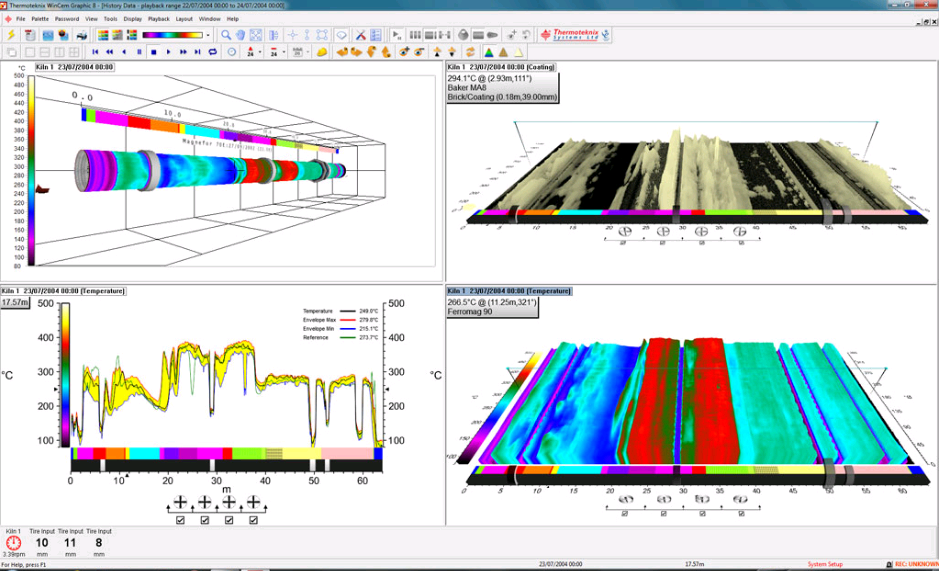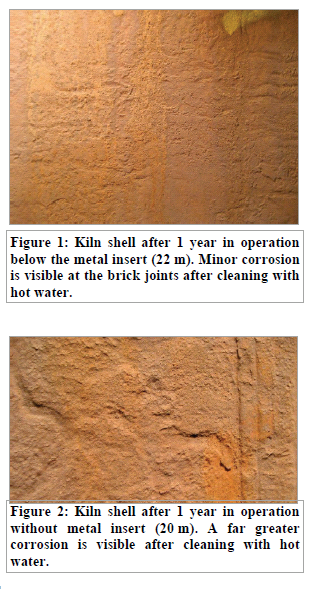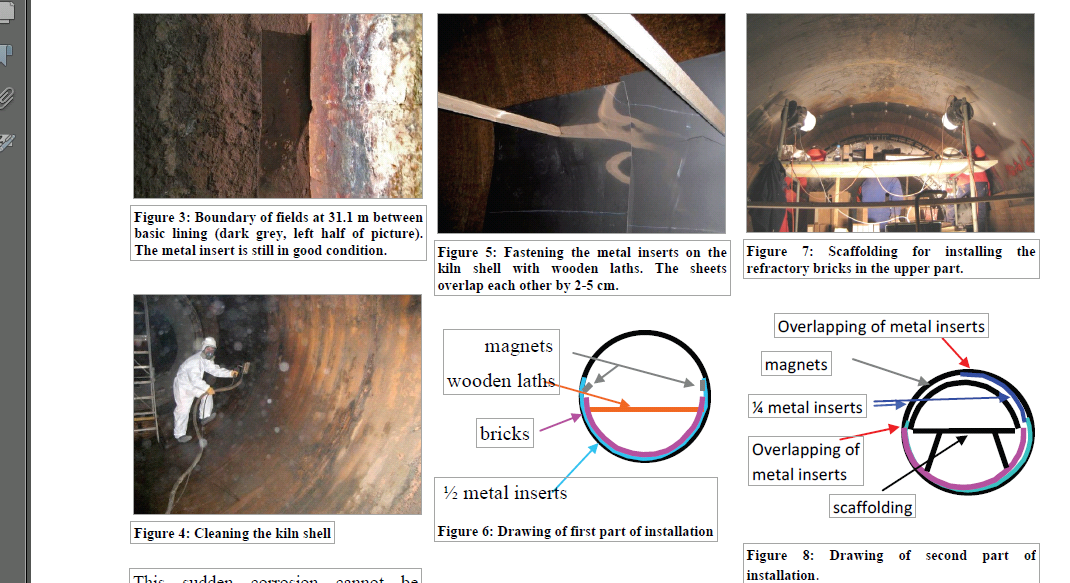Contents
click here to Download the Most Important 13 Books in Cement Industry
click here to Download the Most Important 13 Books in Cement Industry
How to protect the kiln shell against corrosion
Positive experiences from Jura Cement Marcel Bieri, Jura Cement, Switzerland

Like other precalciner kilns that use a significant proportion of refuse-derived fuel and operate without a bypass, the cement rotary 3-base kiln (3,8 m/4,2 m x 56 m, 2000 t clinker/day / Figure 0) at Jura Cement in Wildegg (Switzerland) is also subject to accumulation of alkali chlorides and sulphates by internal cycles that infiltrate the refractory lining and ultimately corrode the kiln shell. The chloride content further increased during the last years due to raising volumes of alternative fuels like shredded plastics, waste solvents and meat and bone meal. During the last years the content of sulphates decreased in the raw material and all the fuels used do not contain significant sulphates (Table 1).
Based on an article published in 2006 [1], tests with stainless-steel inserts were first performed on a new kiln shell in 2008. The tests were extended in the following years and herewith a résumé is given regarding the performance of the metal inserts. The report also describes the installation of the metal inserts and cleaning work required on the kiln shell prior to installation. Parts of this paper were published [2] already in 2010.
Initial tests with metal inserts and further optimisation In the course of replacing part of the kiln shell in January 2008, two 3 m wide sections of the upper transition zone (21.1-24.1 m and 29.1-32.1 m) were covered with 0.4 mm thick metal inserts of steel grade 1.4301 (AISI 304).
After 11 months operation period, the refractory lining of the central sinter zone and the adjoining upper transition zone up to 26.1 m were renewed in January 2009 thus enabling the assessment of the condition of the metal inserts in the area from 21.1-24.1 m. The metal insert was largely destroyed and the kiln shell was covered with black, hygroscopic salts, but after cleaning with hot water, it evolved that the kiln shell was only slightly corroded, mainly at the brick joints; the steel shell was not corroded where two inserts overlapped (i.e. under a layer of 0.8 mm thickness). The stability of the refractory lining was apparently not impaired by the metal insert. In the unprotected area, by contrast, severe corrosion of the kiln shell was observed (Figures 1 and 2).

Based on the results of the first test, it was decided to extend the metal inserts to the area from 17.0-26.1 m. A 0.4 mm steel of grade 1.4301 was used again as it was not possible to obtain any other quality and thickness of metal sheet at short notice. Prior to that the surface of the kiln shell was thoroughly cleaned of salts and residual mortar using high-pressure hot water and then dried.
In January 2010, after 11 months of operation, the refractory lining from the kiln discharge up to 31.5 m was renewed. It was observed that the metal insert was practically undamaged at 17 m, but had disintegrated rather suddenly at 17.8 m with only fragments left up to 26.1 m.


This sudden corrosion cannot be explained by the refractory material – the same type of brick was installed from 15.1-26.1 m – but must rather be linked to the temperature profile and the alkali chloride cycle in the kiln. The area under the second base was inconspicuous (22 m), both during the test and after the removal. In contrast, there was a clear link between metal insert corrosion and the type of refractory lining at 31.1 m . From 29.1-31.1 m, the metal insert installed in January 2008 was no longer to be found under the basic bricks. Under the adjoining feed-side alumina bricks impregnated with silica sol, however, it was well preserved after 2 years of operation (Figure 3).
Because the alumina bricks had not suffered any measurable wear, only two rings were cleared from the transition zone, while the majority were left in the kiln for a third test. The special impregnation of the alumina bricks with silica sol, which reduces permeability to almost 0 nPm on unused bricks, apparently slowed down or neutralized infiltration of alkali chlorides and sulphates from the kiln atmosphere during the operation period of 2 years to such an extent, that the metal insert and the kiln shell below did not suffer any significant corrosion. In view of the good performance of the specially impregnated alumina bricks, it was decided to extend them 3 m towards the discharge end down to 28.1 m. Hence, for the area lined with alumina bricks, a combination of silica sol impregnation and a 0.4 mm-thick metal insert of steel grade 1.4301 (AISI 304) seemed to represent inexpensive and effective protection against corrosion. It is planned to extend the metal insert under the alumina bricks successively up to 45 m.
As it is not possible to do without basic bricks in the upper transition zone for reasons of thermal stability the metal insert was reinforced in two ways during repair in January 2010: Firstly in terms of material, by choosing 1.4404 (AISI 316) steel and secondly in terms of strength, by increasing the thickness of the sheet metal to 0.6 mm. This metal insert was installed between 22.5 and 31.5 m in order to verify the influence of the refractory lining on the quantity of infiltration once again. At that time, steel grade 1.4301 sheet was was available and therefore installed from 17-22.5 m. In 2011 and 2012 the 0.6 mm thick metal insert with steel grade 1.4404 was also used in the section 17-22.5 m. As in previous years the result was a significant reduction of the kiln shell corrosion. However, the 0.6 mm thick metal inserts in the section 22-28 m were largely dissolved after one year. It is quite clear, that this situation must be improved and solutions to solve this problem are being searched for. In 2013, a 0.6 mm thick copper sheet was inserted in order to test whether this material is more resistant to corrosion of the kiln shell.
Installation of Metal inserts
Before installing a new lining, the kiln shell has to be thoroughly cleaned with high-pressure hot water to remove any residual mortar, salt and corroded material sticking to the shell and then dried (Figure 4).
After cleaning, the bottom half-shell is lined with metal sheets fastened to the kiln shell with wooden laths and/or magnets (Figure 5 and 6).
The refractory bricks of the bottom half-shell are installed. Subsequently the scaffolding is installed, the metal inserts inserted and fastened in the top half of the kiln shell, and the refractory bricks are installed on top as usual (Figure 7 and 8).
Conclusions
Jura Cement has successfully installed thin stainless steel sheets between the refractory lining and the kiln shell with the positive impact that shell corrosion caused by alkali chloride infiltration is reduced significantly. At the Jura Cement plant, the 0.6 mm-thick sheet of steel grade 1.4404 (AISI 316) is an ideal protection for a major part of the kiln. Alumina bricks impregnated with silica sol are used with good results on slowing down or neutralizing infiltration of alkali chlorides and sulphates in the section from 28 m upwards. In the section 22-28 m the stainless steel sheets were still largely dissolved after an operation period of 11 months and therefore tests with other material sheets are carried out in order to reach an even better protection of the kiln shell.
References
[1] Nievoll, J., Dávila, J. and Heindl, R. Practical Solutions to Address Precalciner Kiln Shell Corrosion. RHI Bulletin. 2006, 3, pp. 11-14.
[2] Emmenegger, H., Eiselsberg, W. and Nievoll, J. Experience with metal inserts to protect kiln shell at jura cement, Wildegg plant, Switzerland. RHI Bulletin. 2010, 1, pp. 18-20.